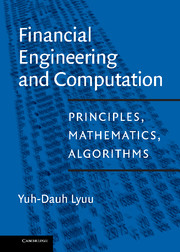Book contents
- Frontmatter
- Contents
- Preface
- Useful Abbreviations
- 1 Introduction
- 2 Analysis of Algorithms
- 3 Basic Financial Mathematics
- 4 Bond Price Volatility
- 5 Term Structure of Interest Rates
- 6 Fundamental Statistical Concepts
- 7 Option Basics
- 8 Arbitrage in Option Pricing
- 9 Option Pricing Models
- 10 Sensitivity Analysis of Options
- 11 Extensions of Options Theory
- 12 Forwards, Futures, Futures Options, Swaps
- 13 Stochastic Processes and Brownian Motion
- 14 Continuous-Time Financial Mathematics
- 15 Continuous-Time Derivatives Pricing
- 16 Hedging
- 17 Trees
- 18 Numerical Methods
- 19 Matrix Computation
- 20 Time Series Analysis
- 21 Interest Rate Derivative Securities
- 22 Term Structure Fitting
- 23 Introduction to Term Structure Modeling
- 24 Foundations of Term Structure Modeling
- 25 Equilibrium Term Structure Models
- 26 No-Arbitrage Term Structure Models
- 27 Fixed-Income Securities
- 28 Introduction to Mortgage-Backed Securities
- 29 Analysis of Mortgage-Backed Securities
- 30 Collateralized Mortgage Obligations
- 31 Modern Portfolio Theory
- 32 Software
- 33 Answers to Selected Exercises
- Bibliography
- Glossary of Useful Notations
- Index
1 - Introduction
Published online by Cambridge University Press: 19 September 2009
- Frontmatter
- Contents
- Preface
- Useful Abbreviations
- 1 Introduction
- 2 Analysis of Algorithms
- 3 Basic Financial Mathematics
- 4 Bond Price Volatility
- 5 Term Structure of Interest Rates
- 6 Fundamental Statistical Concepts
- 7 Option Basics
- 8 Arbitrage in Option Pricing
- 9 Option Pricing Models
- 10 Sensitivity Analysis of Options
- 11 Extensions of Options Theory
- 12 Forwards, Futures, Futures Options, Swaps
- 13 Stochastic Processes and Brownian Motion
- 14 Continuous-Time Financial Mathematics
- 15 Continuous-Time Derivatives Pricing
- 16 Hedging
- 17 Trees
- 18 Numerical Methods
- 19 Matrix Computation
- 20 Time Series Analysis
- 21 Interest Rate Derivative Securities
- 22 Term Structure Fitting
- 23 Introduction to Term Structure Modeling
- 24 Foundations of Term Structure Modeling
- 25 Equilibrium Term Structure Models
- 26 No-Arbitrage Term Structure Models
- 27 Fixed-Income Securities
- 28 Introduction to Mortgage-Backed Securities
- 29 Analysis of Mortgage-Backed Securities
- 30 Collateralized Mortgage Obligations
- 31 Modern Portfolio Theory
- 32 Software
- 33 Answers to Selected Exercises
- Bibliography
- Glossary of Useful Notations
- Index
Summary
But the age of chivalry is gone. That of sophisters, oeconomists, and calculators, has succeeded; and the glory of Europe is extinguished for ever.
Edmund Burke (1729–1797), Reflections on the Revolution in FranceModern Finance: A Brief History
Modern finance began in the 1950s [659, 666]. The breakthroughs of Markowitz, Treynor, Sharpe, Lintner (1916–1984), and Mossin led to the Capital Asset Pricing Model in the 1960s, which became the quantitative model for measuring risk. Another important influence of research on investment practice in the 1960s was the Samuelson–Fama efficient markets hypothesis, which roughly says that security prices reflect information fully and immediately. The most important development in terms of practical impact, however, was the Black–Scholes model for option pricing in the 1970s. This theoretical framework was instantly adopted by practitioners. Option pricing theory is one of the pillars of finance and has wide-ranging applications [622, 658].The theory of option pricing can be traced to Louis Bachelier's Ph.D. thesis in 1900, “Mathematical Theory of Speculation.” Bachelier (1870–1946) developed much of the mathematics underlying modern economic theories on efficient markets, random-walk models, Brownian motion [ahead of Einstein (1879–1955) by 5 years], and martingales [277, 342, 658, 776].
Financial Engineering and Computation
Today, the wide varieties of financial instruments dazzle even the knowledgeable. Individuals and corporations can trade, in addition to stocks and bonds, options, futures, stock index options, and countless others. When it comes to diversification, one has thousands of mutual funds and exchange-traded funds to choose from. Corporations and local governments increasingly use complex derivative securities to manage their financial risks or even to speculate.
- Type
- Chapter
- Information
- Financial Engineering and ComputationPrinciples, Mathematics, Algorithms, pp. 1 - 6Publisher: Cambridge University PressPrint publication year: 2001



